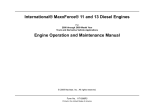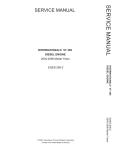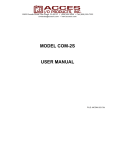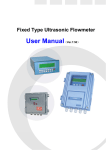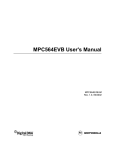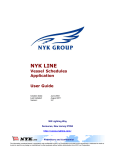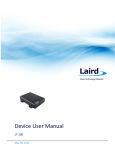Download Technical Service Information
Transcript
Technical Service Information TSI–05–12–07 This TSI replaces 04–12–11 that replaced Test 16 Low ICP System Pressure in “Hard Start and No Start Diagnostics” Section 5 of EGES-240. Date: April 2005 Subject File: Engines Subject: Low Injection Control Pressure (ICP) Test Engine Family: International® VT 365 2004 MY Diesel Engines SN Range: 112360-Up Description File this TSI-05-12-07 in Appendix C of Engine Diagnostic Manual. Also, file a copy of TSI-05-12-07 in the TSI library. New photo illustrations and procedures were added for using new tools. The ICP Adapter/Plug Kit and Crankcase-to-head Tube Removal Tool were released to support the introduction of a running change to the Crankcase-to-head tubes. Reference TSI-05-12-11. NOTE: Follow the procedures in this TSI. Failure to follow procedures in sequence can lead to incorrect test results. 1 Read all safety instructions in the "Safety Information" section of this manual before doing any procedures. Follow all warnings, cautions, and notes. © 2005 International Truck and Engine Corporation 16. Low ICP System Pressure Figure 1 NOTE: Make copies of the Low ICP System Pressure Chart on last page (Figure 33). Record test results on this chart. • Crankcase Pressure Test Adapter • ICP System Test Adapter • ICP Adapter/Plug Kit (Short) Purpose – ICP Sensor Adapter To determine the cause of low injection control pressure that prevents engine starting – ICP Leak Test Plug • Tools • EST with MasterDiagnostics® • EZ-Tech® interface cable • DMM (Digital multimeter) • Actuator Breakout Harness • Pressure Sensor Breakout Harness TSI–05–12–07 ICP Adapter/Plug Kit (Long) – ICP Sensor Adapter – ICP Leak Test Plug • Oil fill extension • Compressed air source 689 kPa (100 psi) 2 Read all safety instructions in the "Safety Information" section of this manual before doing any procedures. Follow all warnings, cautions, and notes. © 2005 International Truck and Engine Corporation 16. Low ICP System Pressure (cont.) NOTE: The IPR coil can be rotated 90 degrees to make disconnection and inspection easier. (Tools are not required.) WARNING: To avoid serious personal injury, possible death, or damage to the engine or vehicle, read all safety instructions in the “Safety Information” section of Engine Diagnostic manual. NOTE: Do the following procedures in sequence or test results will be incorrect. Before starting Test 16.1 System Function, make sure the engine lubrication system will build oil pressure, while the engine is cranking. • If there is corrosion on either the IPR valve or the wiring harness connector for the IPR valve, replace both the IPR valve and wiring harness connector for the IPR valve. Retest ICP pressure. • If the wiring harness connector and IPR valve are not corroded or damaged, continue with step 3. CAUTION: If the IPR coil was rotated, return IPR valve to the weather protected position as shown above, after repairs are made Continue Test 16.1, if terminals on the Injection Pressure Regulator (IPR) valve and engine harness are not damaged or corroded. 16.1 System Function 2. Connect Actuator Breakout Harness only to the IPR valve. CAUTION: If the engine harness is connected to the actuator breakout Harness, the VIGN fuse will blow or cause damage to wiring harness. Figure 2 position 1. 2. IPR valve coil in weather protected IPR valve coil with heat shield Engine harness connector 1. Disconnect engine wiring harness from IPR valve and inspect engine wiring harness connector and IPR valve terminal for corrosion. Inspect terminal for bent pins, or pushed back pins. Figure 3 3 B+ on power distribution post TSI–05–12–07 Read all safety instructions in the "Safety Information" section of this manual before doing any procedures. Follow all warnings, cautions, and notes. © 2005 International Truck and Engine Corporation 16. Low ICP System Pressure (cont.) WARNING: To avoid serious personal injury, possible death or damage to the engine or vehicle, understand and comply with the following: While cranking the engine, the engine could start. Before cranking the engine do the following: Figure 4 Set the parking brake. • Put the Transmission in neutral. • Block the wheels. If the engine starts, turn ignition switch to OFF and disconnect B+ or ground to the Actuator Breakout Harness. Ground to post on cowl 3. Apply B+ volts and ground to the IPR valve. 4. Crank the engine and monitor ICP pressure using the EST or DMM and Pressure Sensor Breakout Harness. CAUTION: Do not leave the IPR valve energized longer than 120 seconds. This can damage the IPR valve. TSI–05–12–07 • 5. Record results on Low ICP System Pressure Chart (Figure 33). • If ICP increases above 3.45 MPa (500 psi) (0.82 volts), the mechanical system is operating correctly for the engine to start. Do not continue with ICP system diagnostics. • Check Diagnostic Trouble Codes (DTCs) recorded during test 8 on Electronic Control System Diagnostics form EGED-245. (Make sure problems were corrected.) • For problems in the electrical circuit, see Section 7 in Engine Diagnostics Manual . • If 3.45 MPa (500 psi) (0.82 volts) can not be reached, continue with test 16.2 IPR Function. 4 Read all safety instructions in the "Safety Information" section of this manual before doing any procedures. Follow all warnings, cautions, and notes. © 2005 International Truck and Engine Corporation 16. Low ICP System Pressure (cont.) 4. Remove ICP sensor from the right oil rail. 16.2 IPR Function NOTE: Before doing this test, inspect O-ring for the ICP Sensor Adapter and D-rings for ICP Leak Test Plug. Replace if worn, cracked or cut. Figure 6 ICP System Test Adapter Figure 7 ICP system test assembly Figure 5 Oil fill extension and Crankcase Pressure Test Adapter 1. 2. Crankcase Pressure Test Adapter Oil fill extension (Part No. 1830971C91) 1. Remove the oil fill cap from oil fill extension. 2. Insert Crankcase Pressure Test Adapter or a piece of rubber hose into oil fill extension. NOTE: The Crankcase Pressure Test Adapter or rubber hose will magnify the sound of an air leak. 1. 2. 3. 3. Disconnect engine harness from ICP sensor. 5 Air chuck Shutoff valve ICP System Test Adapter TSI–05–12–07 Read all safety instructions in the "Safety Information" section of this manual before doing any procedures. Follow all warnings, cautions, and notes. © 2005 International Truck and Engine Corporation 16. Low ICP System Pressure (cont.) WARNING: To avoid serious personal injury, possible death or damage to the engine or vehicle, make sure the shutoff valve is closed. 7. Connect the compressed air supply line to air chuck. Figure 8 1. 2. 3. 4. 8. Apply 689 kPa (100 psi) of pressure and open shutoff valve. Use Crankcase Pressure Test Adapter or hose to listen for an air leak. ICP system test assembly with hose NOTE: When air pressure is first applied, it may take up to 5 minutes before an air leak can be heard. This allows air pressure to displace the engine oil in the ICP system. Once engine oil is displaced, an air leak can be heard almost immediately. Air chuck Shutoff valve Hose ICP System Test Adapter 5. Assemble ICP System Test Adapter to a shutoff valve and an air chuck. • NOTE: Depending on chassis application, a hose may be used to provide easier access for a compressed air supply. A faint air leak should be heard. Air should be passing through the IPR valve and returning to the crankcase when the IPR valve is not energized. 9. Record the results on Low ICP System Pressure Chart (Figure 33). 10. Connect the Actuator Breakout Harness to the IPR valve and apply B+ and ground. (Compressed air supply should still be applied to the ICP system.) Use Crankcase Pressure Test Adapter or hose to listen for an air leak. CAUTION: Do not leave the IPR valve energized longer than 120 seconds. This can damage the IPR valve. 11. Record results on Low ICP System Pressure Chart (Figure 33). Figure 9 1. 2. 3. • When the IPR valve is energized, the air leak should stop. • If a faint air leak is still heard, replace the IPR valve. Follow procedure in the Engine Service Manual. Repeat step 10 to verify if the IPR valve is functioning correctly. ICP system test assembly Air chuck Shutoff valve ICP System Test Adapter 6. Install ICP system test assembly. (ICP System Test Adapter, shutoff valve, and air chuck) TSI–05–12–07 6 Read all safety instructions in the "Safety Information" section of this manual before doing any procedures. Follow all warnings, cautions, and notes. © 2005 International Truck and Engine Corporation 16. Low ICP System Pressure (cont.) • • If a loud air leak is heard while the IPR valve energized or a leak is still heard after replacement of an IPR valve, continue with 16.3 Under Valve Cover Leaks. 7 If an air leak is not heard when the IPR valve is energized, continue with 16.5 High-pressure Pump. This test result indicates no leaks in the high-pressure oil system. TSI–05–12–07 Read all safety instructions in the "Safety Information" section of this manual before doing any procedures. Follow all warnings, cautions, and notes. © 2005 International Truck and Engine Corporation 16. Low ICP System Pressure (cont.) 16.3 Under Valve Cover Leaks 4. Reinstall ICP system test assembly. (ICP System Test Adapter, shutoff valve, and air chuck) NOTE: Before doing this test, inspect the O-ring for the ICP Sensor Adapter and D-rings for the ICP Leak Test Plug. Replace if worn, cracked or cut. 1. Close shutoff valve compressed air. before WARNING: To avoid serious personal injury, possible death or damage to the engine or vehicle, make sure the shutoff valve is closed. disconnecting WARNING: To avoid serious personal injury, possible death or damage to the engine or vehicle, make sure the shutoff valve is closed. 5. Connect the compressed air supply line to air chuck. 6. Apply 689 kPa (100 psi) of pressure and open shutoff valve. Use Crankcase Pressure Test Adapter or hose to listen for an air leak. 2. Remove ICP system test assembly. (ICP System Test Adapter, shutoff valve, and air chuck) • 3. Remove the left and right valve covers. Follow the procedures in the Engine Service Manual. A faint air leak should be heard. Air should be passing through the IPR valve and returning to the crankcase when the IPR valve is not energized. 7. Use the Actuator Breakout Harness to apply B+ and ground to the IPR valve. NOTE: This will help you hear where the leak is coming from. CAUTION: Do not leave the IPR valve energized longer than 120 seconds. This can damage the IPR valve. 8. Record results on Low ICP System Pressure Chart (Figure 33). Figure 10 cover off 1. 2. 3. Compressed air supply with valve Repair any defects found in the area under the valve covers. If more detailed instructions are needed to isolate a leak in the oil rail area, see 16.4 Cylinder Head Isolation. Retest after repairs to verify mechanical operation of the ICP system. • If leaks are not detected in areas under the valve covers, but air leaks are coming from the crankcase, continue with step 9. 9. Remove ICP system test assembly (ICP System Test Adapter, shutoff valve, and air chuck) from right oil rail. Air chuck Shutoff valve ICP System Test Adapter TSI–05–12–07 • 10. Install the ICP sensor into right oil rail. 8 Read all safety instructions in the "Safety Information" section of this manual before doing any procedures. Follow all warnings, cautions, and notes. © 2005 International Truck and Engine Corporation 16. Low ICP System Pressure (cont.) Figure 11 Socket heads for long and short crankcase-to-head tube plugs 1. 2. Hex head socket (Long crankcase-to-head tube plugs and common rail port plugs) Square head socket (Short crankcase-to-head tube plugs and common rail port plugs) Figure 13 1. 2. ICP Adapter/Plug Kit (Long) ICP Sensor Adapter (Threaded hex head) ICP Leak Test Plug (Solid hex head) CAUTION: To avoid damage to the engine, make sure the crankcase-to-head tube plug (long or short) is installed with the correct crankcase-to-head tube. Figure 12 1. 2. ICP Adapter/Plug Kit (Short) ICP Sensor Adapter (Threaded hex head) ICP Leak Test Plug (Solid hex head) 9 TSI–05–12–07 Read all safety instructions in the "Safety Information" section of this manual before doing any procedures. Follow all warnings, cautions, and notes. © 2005 International Truck and Engine Corporation 16. Low ICP System Pressure (cont.) CAUTION: To avoid damage to D-rings that could cause a high-pressure oil leak, lubricate the D-rings with clean engine oil before installing the crankcase-to-head tubes. • If the wrong diagnostic tool is used, a misdiagnosis will result. 12. Install ICP system test assembly. (ICP System Test Adapter, shutoff valve, and air chuck) Figure 14 ICP system test assembly and ICP Sensor Adapter (Right cylinder head) 1. 2. 3. 4. 5. Air chuck Shutoff valve ICP System Test Adapter ICP Sensor Adapter ICP sensor 11. Remove the crankcase-to-head tube plug in the rear of right side oil rail and install the ICP Sensor Adapter in this port. NOTE: Understand and comply with the following: • This will block air flow to the right oil rail and injectors. • If the long crankcase-to-head tube plug is removed and the crankcase-to-head tube is still attached, use mild cleaner to remove oil from D-rings and inspect. Figure 15 Crankcase-to-head tube plug (Short) and ICP Leak Test Plug (Short) 1. 2. Crankcase-to-head tube plug ICP Leak Test Plug (Solid hex head) If D-rings are damaged, replace the crankcase-to-head tube assembly and retest. If D-rings are not damaged remove tube from plug. Attach crankcase-to-head tube to ICP Sensor Adapter. Install assembly and continue with step 12. TSI–05–12–07 10 Read all safety instructions in the "Safety Information" section of this manual before doing any procedures. Follow all warnings, cautions, and notes. © 2005 International Truck and Engine Corporation 16. Low ICP System Pressure (cont.) NOTE: Understand and comply with the following: • This will block air flow to the left oil rail and injectors. • If the long crankcase-to-head tube plug is removed and the crankcase-to-head tube is still attached, use mild cleaner to remove oil from D-rings and inspect. If D-rings are damaged, replace the crankcase-to-head tube assembly and retest. If D-rings are not damaged remove tube from plug. Attach crankcase-to-head tube to ICP Leak Test Plug. Install assembly and continue with step 14. CAUTION: To avoid damage to D-rings that could cause a high-pressure oil leak, lubricate the D-rings with clean engine oil before installing the crankcase-to-head tubes. Figure 16 Crankcase-to-head tube plug (Long) and ICP leak test plug (Long) 1. 2. • If the wrong diagnostic tool is used, a misdiagnosis will result. Crankcase-to-head tube plug ICP Leak Test Plug (Solid hex head) WARNING: To avoid serious personal injury, possible death or damage to the engine or vehicle, make sure the shutoff valve is closed. 14. Connect compressed air supply line to air chuck. 15. Apply 689 kPa (100 psi) of pressure and open shutoff valve. Use Crankcase Pressure Test Adapter or hose to listen for an air leak. • Figure 17 1. A faint air leak should be heard. Air should be passing through the IPR valve and returning to the crankcase when the IPR valve is not energized. 16. Use the Actuator Breakout Harness to apply B+ and ground to the IPR valve. ICP leak test plug (Long) ICP Leak Test Plug (Solid hex head) CAUTION: Do not leave the IPR valve energized longer than 120 seconds. This can damage the IPR valve. 13. Remove the crankcase-to-head tube plug from the rear of the left side oil rail. Install the ICP Leak Test Plug in this port. 11 TSI–05–12–07 Read all safety instructions in the "Safety Information" section of this manual before doing any procedures. Follow all warnings, cautions, and notes. © 2005 International Truck and Engine Corporation 16. Low ICP System Pressure (cont.) 17. Listen for an air leak. • If an air leak is heard coming from the crankcase, proceed with step 18. • If an air leak is not heard, one or more injector O-rings or oil rail O-rings are the cause of leak. If unable to tell which side is leaking, do test 16.4 Cylinder Head Isolation. WARNING: To avoid serious personal injury, possible death or damage to the engine or vehicle, make sure the shutoff valve is closed. 18. Disconnect the compressed air supply from ICP system test assembly. Figure 18 1. 2. 3. 4. Figure 19 Crankcase-to-head tube and crankcase-to-head Tube Removal Tool Crankcase-to-head tubes Crankcase-to-head tube plug (Short) Crankcase-to-head tube (Used with short rail plug) Crankcase-to-head tube plug (Long) Crankcase-to-head tube (Used with long rail plug) 1. 2. Crankcase-to-head tube Crankcase-to-head Tube Removal Tool NOTE: If crankcase-to-head tube is not attached to the leak test plug or sensor adapter, use ZTSE4694 crankcase-to-head tube removal tool to remove tube from crankcase. 19. Remove the questionable crankcase-to-head tube or tubes from the engine and inspect D-rings. Follow the procedures in the Engine Service Manual. 20. Clean the crankcase-to-head tube and D-rings. NOTE: Use mild cleaner to remove oil from D-rings. Dry D-rings and inspect. TSI–05–12–07 • If D-rings are damaged, replace the crankcase-to-head tube assembly and retest. • If D-rings are not damaged, install the crankcase-to-head tube or tubes and continue with step 21. 12 Read all safety instructions in the "Safety Information" section of this manual before doing any procedures. Follow all warnings, cautions, and notes. © 2005 International Truck and Engine Corporation 16. Low ICP System Pressure (cont.) CAUTION: To avoid damage to D-rings that could cause a high-pressure oil leak, lubricate the D-rings with clean engine oil before installing the crankcase-to-head tubes. WARNING: To avoid serious personal injury, possible death or damage to the engine or vehicle, make sure the shutoff valve is closed. 22. Connect the compressed air supply line to the ICP System Test Adapter. 23. Apply 689 kPa (100 psi) of pressure and open shutoff valve. • A faint air leak should be heard. Air should be passing through the IPR valve and returning to the crankcase when the IPR valve is not energized. 24. Use the Actuator Breakout Harness to apply B+ and ground to the IPR valve. CAUTION: Do not leave the IPR valve energized longer than 120 seconds. This can damage the IPR valve. Figure 20 High-pressure pump cover CAUTION: To avoid engine damage or high-pressure oil leaks, follow procedures in the Engine Service manual for removing the high-pressure pump cover. 21. Remove the high-pressure pump cover, following procedures in the Engine Service Manual. Figure 21 Possible leak areas in branch tube connection to the discharge port of high-pressure pump 1. 2. 13 Quick disconnect Branch Tube Adapter TSI–05–12–07 Read all safety instructions in the "Safety Information" section of this manual before doing any procedures. Follow all warnings, cautions, and notes. © 2005 International Truck and Engine Corporation 16. Low ICP System Pressure (cont.) Figure 23 Possible leak areas under high-pressure pump Figure 22 Possible leak areas in Branch Tube Assembly 1. 2. 3. 4. 5. 1. 2. 3. Left branch tube block Right branch tube block Quick disconnect Branch Tube Adapter Center branch tube block 26. Listen for air leaks in both O-ring areas under the high-pressure pump, 25. Check for air leaks in the Branch Tube Assembly connection to the discharge port of high-pressure pump and the Branch Tube Adapter. TSI–05–12–07 O-ring for high-pressure oil pump inlet Branch Tube Assembly O-ring for Branch Tube Adapter • If an air leak is not detected in the area under the high-pressure cover, but an air leak is heard, replace the Branch Tube Assembly. • If an air leak is located or detected, repair or replace as required. 14 Read all safety instructions in the "Safety Information" section of this manual before doing any procedures. Follow all warnings, cautions, and notes. © 2005 International Truck and Engine Corporation 16. Low ICP System Pressure (cont.) 16.4. Cylinder Head Isolation NOTE: Before doing this test, inspect the D-rings for the ICP Leak Test Plug. Replace if worn, cracked or cut. Depending on which rail is being tested, the complete test setup must be on the same side. Figure 25 ICP Leak Test Plug and ICP System Test Adapter (Left cylinder head) 1. 2. 3. 4. Figure 24 ICP Leak Test Plug and ICP System Test Adapter (Right cylinder head) 1. 2. 3. 4. ICP Leak Test Plug ICP System Test Adapter Shutoff valve Air chuck 1. Remove the crankcase-to-head tube plug from the rear of the oil rail. Install the ICP Leak Test Plug in this port. ICP Leak Test Plug Air chuck Shutoff valve ICP System Test Adapter NOTE: Understand and comply with the following: • This will contain air flow to the oil rail and injectors. • When crankcase-to-head tube plug is removed, the crankcase-to-head tube may still be attached. Remove tube from plug. Install tube to leak test plug for testing. CAUTION: To avoid damage to D-rings that could cause a high-pressure oil leak, lubricate the D-rings with clean engine oil before installing the crankcase-to-head tubes. • 15 If the wrong diagnostic tool is used, a misdiagnosis will result. TSI–05–12–07 Read all safety instructions in the "Safety Information" section of this manual before doing any procedures. Follow all warnings, cautions, and notes. © 2005 International Truck and Engine Corporation 16. Low ICP System Pressure (cont.) NOTE: When air pressure is first applied, it may take up to 5 minutes before the leak can be heard. This allows the air pressure to displace the engine oil in the ICP system. Once the engine oil is displaced, an air leak can be heard almost immediately after applying air pressure. 2. Install ICP system test assembly (ICP System Test Adapter, shutoff valve, and air chuck) into ICP sensor port. • ICP sensor removed from right cylinder head • Plug removed from left cylinder head 4. Apply 689 kPa (100 psi) of pressure, open shutoff valve, and listen for an air leak. WARNING: To avoid serious personal injury, possible death or damage to the engine or vehicle, make sure the shutoff valve is closed. 5. Record results on Low ICP System Pressure Chart (Figure 33). • If an air leak is not detected, the air leak may be coming from the crankcase or opposite cylinder head. Verify previous test results and repeat procedure for opposite cylinder head. • If an air leak is detected, repair as needed and verify the integrity of the repairs. 3. Connect compressed air supply line to air chuck. TSI–05–12–07 16 Read all safety instructions in the "Safety Information" section of this manual before doing any procedures. Follow all warnings, cautions, and notes. © 2005 International Truck and Engine Corporation 16. Low ICP System Pressure (cont.) 16.5 High-pressure Pump NOTE: Do this test only if Test 16.2 did not have leaks and EST Data List test had low ICP. NOTE: Before doing this test, inspect the D-rings for the ICP Sensor Adapter and ICP Leak Test Plug. Replace if worn, cracked or cut. WARNING: To avoid serious personal injury, possible death or damage to the engine or vehicle, make sure the shutoff valve is closed. Figure 27 plug 1. Close shutoff valve in ICP system test assembly, before disconnecting compressed air supply. 1. 2. 2. Remove ICP system test assembly. (ICP System Test Adapter, shutoff valve, and air chuck) ICP sensor adapter and ICP leak test ICP sensor adapter (threaded hex head). ICP leak test plug (solid hex head). 3. Remove the left and right valve covers, following procedures in the Engine Service Manual. Figure 26 1. 2. Crankcase-to-head tube plugs New (hex head) long crankcase-to-head tube plug Old (square head) short crankcase-to-head tube plug Figure 28 1. 2. 17 ICP Adapter/Plug Kit ICP Sensor Adapter (Threaded hex head) ICP Leak Test Plug (Solid hex head) TSI–05–12–07 Read all safety instructions in the "Safety Information" section of this manual before doing any procedures. Follow all warnings, cautions, and notes. © 2005 International Truck and Engine Corporation 16. Low ICP System Pressure (cont.) CAUTION: To avoid damage to the engine, make sure the crankcase-to-head tube plug (long or short) is installed with the correct crankcase-to-head tube. 4. Remove the crankcase-to-head tube plug in the rear of right side oil rail and install the ICP Sensor Adapter in this port. NOTE: Understand and comply with the following: • This will block oil flow to the right oil rail and injectors. • When crankcase-to-head tube plug is removed, the crankcase-to-head tube may still be attached. Remove tube from plug. Install tube to ICP Sensor Adapter for testing. Figure 29 Crankcase-to-head tube plug and ICP Leak Test Plug 1. 2. Crankcase-to-head tube plug ICP Leak Test Plug (Solid hex head) CAUTION: To avoid damage to D-rings that could cause a high-pressure oil leak, lubricate the D-rings with clean engine oil before installing the crankcase-to-head tubes. • Figure 31 ICP sensor with ICP Sensor Adapter (Right cylinder head) Figure 30 Crankcase-to-head tube plug and ICP Leak Test Plug 1. 2. 1. 2. 3. Crankcase-to-head tube plug ICP Leak Test Plug TSI–05–12–07 If the wrong diagnostic tool is used, a misdiagnosis will result. Pressure Sensor Breakout Harness ICP sensor ICP Sensor Adapter 18 Read all safety instructions in the "Safety Information" section of this manual before doing any procedures. Follow all warnings, cautions, and notes. © 2005 International Truck and Engine Corporation 16. Low ICP System Pressure (cont.) NOTE: Steps 4–7 block oil flow to both rails and all injectors; only the branch tube assembly, crankcase-to-head tube, and the high-pressure pump will be tested. 5. Install ICP sensor into ICP Sensor Adapter. 6. Connect the engine wiring harness to the ICP sensor. Use the Pressure Sensor Breakout Harness as an extension, if needed. 8. Use the Actuator Breakout Harness to apply B+ and ground to the IPR valve. CAUTION: Do not leave the IPR valve energized longer than 120 seconds. This can damage the IPR valve. Figure 32 head) WARNING: To avoid serious personal injury, possible death, or damage to the engine or vehicle, comply with the following: While cranking the engine, the engine could start. Before cranking the engine do the following: ICP Leak Test Plug (Left cylinder 7. Remove the crankcase-to-head tube plug from the rear of the left side oil rail. Install the ICP Leak Test Plug in this port. This will block oil flow to the left oil rail and injectors. • When crankcase-to-head tube plug is removed, the crankcase-to-head tube may still be attached. Remove tube from plug. Install tube to leak test plug for testing. Set the parking brake. • Put the transmission in neutral. • Block the wheels. If the engine starts, turn ignition switch to OFF and disconnect B+ or ground to the Actuator Breakout Harness. NOTE: Understand and comply with the following: • • When the ICP sensor is removed from the right side oil rail during testing, be sure all personnel are standing a safe distance from the right side of the engine. • CAUTION: To avoid damage to D-rings that could cause a high-pressure oil leak, lubricate the D-rings with clean engine oil before installing the crankcase-to-head tubes. If D-rings on the test tools are worn, cracked or cut, oil can bypass D-rings and flow out the ICP sensor port. 9. Crank the engine and monitor ICP pressure. 10. Record results on Low ICP Pressure System Chart (Figure 33). • • If the wrong diagnostic tool is used, a misdiagnosis will result. 19 If unable to build the ICP pressure above 3.45 MPa (500 psi) (0.82 volts), replace the high pressure pump. Follow the procedure in the Engine Service Manual. Retest to verify repairs. TSI–05–12–07 Read all safety instructions in the "Safety Information" section of this manual before doing any procedures. Follow all warnings, cautions, and notes. © 2005 International Truck and Engine Corporation 16. Low ICP System Pressure (cont.) • If able to build ICP pressure above 3.45 MPa (500 psi) (0.82 volts), check previous test results. Remove the ICP Leak Test Plug from the left side oil rail and reinstall crankcase-to-head-tube plug. Continue with step 11. 11. Crank the engine and monitor the ICP pressure. CAUTION: To avoid damage to D-rings that could cause a high-pressure oil leak, lubricate the D-rings with clean engine oil before installing the crankcase-to-head tubes. If unable to build the ICP pressure above 3.45 MPa (500 psi) (0.82 volts), the problem is on left side. Do test 16.4 Cylinder head Isolation and check for leaks. • If able to build ICP pressure above 3.45 MPa (500 psi) (0.82 volts), remove ICP Test Adapter from right side oil rail and reinstall crankcase-to-head-tube plug. Reinstall ICP sensor. Reconnect ICP sensor to engine wiring harness. Continue with step 12. 12. Crank the engine and monitor ICP pressure. CAUTION: To prevent engine damage, it is recommend that the crankcase-to-head tubes be replaced, if removed. D-rings are not replaceable. If the crankcase-to-head tubes are to be reused, inspect each D-ring for cuts, abrasion, and twisting; do not reuse a crankcase-to-head tube having any of these conditions, because the tubes will leak. TSI–05–12–07 • • If unable to build the ICP pressure above 3.45 MPa (500 psi) (0.82 volts), the problem is on right side. Do test 16.4 Cylinder head Isolation and check for leaks. • If able to build pressure the engine will start and run. Install valve covers, following the procedures in the Engine Service Manual. 20 Read all safety instructions in the "Safety Information" section of this manual before doing any procedures. Follow all warnings, cautions, and notes. © 2005 International Truck and Engine Corporation Figure 33 Low ICP System Pressure Chart 21 TSI–05–12–07 Read all safety instructions in the "Safety Information" section of this manual before doing any procedures. Follow all warnings, cautions, and notes. © 2005 International Truck and Engine Corporation






















